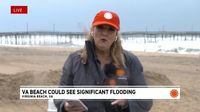As the Northeast and Southeast coasts of the United States brace for the brunt of a powerful Nor’easter, communities from Avalon Bay, New Jersey, to the Outer Banks of North Carolina and down to Virginia Beach are facing some of the most severe coastal flooding and wind events of the 2025 hurricane season. The storm, which began building momentum over the Columbus Day weekend, has already brought rounds of high tides, dangerous flooding, and fierce winds, leaving residents and officials scrambling to mitigate its impact.
According to AccuWeather, high tides and coastal floods started to hammer the Southeast ahead of the storm, with coastal flooding already underway along the East Coast as a tropical wind and rainstorm built off the shoreline. The situation quickly escalated, and by the morning of October 13, 2025, the National Weather Service had issued coastal flood warnings for areas like Avalon Bay, New Jersey, effective until 8 pm Monday. These warnings predicted rounds of 2-3 feet of coastal inundation around high tides, a scenario that played out dramatically in the region as bay water surged into low-lying neighborhoods.
The Nor’easter, a type of powerful storm system that typically brings strong winds, heavy precipitation, and coastal flooding to the northeastern United States, is notorious for its capacity to disrupt life along the Atlantic coast. But what makes this storm particularly menacing is its timing and intensity. As AccuWeather highlighted, this Columbus Day weekend coastal storm could be the most impactful of the 2025 hurricane season—a season already marked by several notable weather events.
High wind warnings were also in effect across the region, with gusts expected to reach up to 60 mph until 6 am Monday, October 13, 2025. These winds, combined with the astronomical high tides typical for this time of year, created the perfect recipe for widespread flooding. According to weather authorities, the combination of wind-driven waves and persistent onshore flow forced seawater into bays and estuaries, overwhelming drainage systems and inundating roadways and properties.
Virginia Beach, in particular, found itself in the crosshairs of the storm. AccuWeather reported that significant flooding was expected in the area during the storm’s peak. Residents along the Virginia coast and in the Carolinas were urged to prepare for the worst, as tropical conditions threatened to batter the region throughout the weekend. North Carolina’s Outer Banks, a chain of barrier islands especially vulnerable to storm surge and coastal erosion, also faced a major threat from the advancing storm system.
Local officials up and down the coast moved quickly to respond. Emergency management teams in New Jersey, Virginia, and North Carolina activated flood response protocols, closed vulnerable roadways, and issued evacuation advisories in the most at-risk neighborhoods. In Avalon Bay, the sight of bay water pouring into streets and yards was a stark reminder of the power of nature and the vulnerability of coastal communities. Residents hurried to move vehicles to higher ground, sandbag doorways, and secure outdoor furniture as the storm’s winds intensified.
Coastal flooding is not a new phenomenon for these regions, but the scale and severity of this event have set it apart. According to AccuWeather’s coverage, the difference between a subtropical storm and a Nor’easter lies in their origins and structure. While subtropical storms often form over warmer waters and have characteristics of both tropical and extratropical systems, Nor’easters are fueled by the clash of cold and warm air masses along the East Coast, often resulting in more widespread and prolonged impacts.
The current Nor’easter, however, has blurred some of those lines. Its development was influenced by tropical moisture and wind patterns, leading to conditions more commonly associated with hurricanes or subtropical storms. This hybrid nature has made forecasting and preparation more challenging for meteorologists and emergency planners alike.
As the storm moved up the coast, it drew in moisture from remnants of other tropical systems—Priscilla and Raymond—which had previously threatened flooding across the Southwest. This additional moisture contributed to heavier rainfall totals and exacerbated the risk of flash flooding in urban and low-lying areas. In some places, rainfall rates exceeded what local drainage systems could handle, leading to rapid accumulations of water and dangerous driving conditions.
For many residents, the storm’s arrival was a rude interruption to what should have been a festive holiday weekend. Businesses along the boardwalks of New Jersey and Virginia reported closures due to flooding, while beachgoers and tourists were advised to stay away from the water’s edge. In some communities, power outages became a concern as wind gusts toppled trees and downed utility lines.
Despite the challenges, local officials and emergency responders showed remarkable resilience and coordination. In Virginia Beach, crews worked through the night to clear debris from storm drains and assist stranded motorists. In Avalon Bay, police and fire departments patrolled flooded neighborhoods, checking on vulnerable residents and providing updates through social media and local news outlets.
“We’re urging everyone to stay off the roads unless absolutely necessary,” one emergency official in New Jersey was quoted as saying. “Floodwaters can rise quickly, and even a few inches can be enough to stall a car or knock someone off their feet.”
Looking ahead, meteorologists warned that the threat was not over. With coastal flood warnings in effect until Monday evening and high wind warnings lasting into the early hours, the risk of additional flooding and property damage remained high. Residents were advised to monitor official updates, heed evacuation orders, and avoid unnecessary travel until conditions improved.
While the Nor’easter’s full impact will only become clear in the days to come, its arrival has already served as a sobering reminder of the power of nature and the importance of preparedness. As climate change continues to influence weather patterns and sea levels, events like this may become more common—and more destructive—in the years ahead.
For now, communities along the Atlantic coast are focused on weathering the storm, supporting their neighbors, and beginning the long process of recovery once the waters recede and the winds die down.




